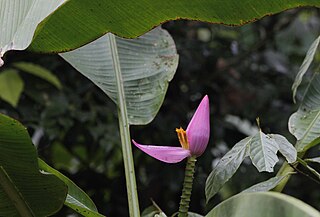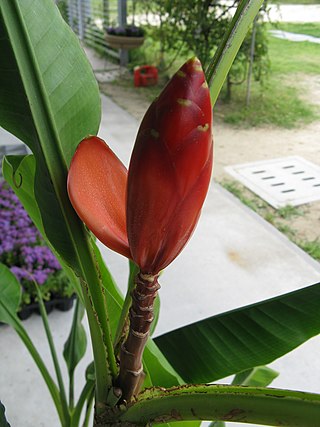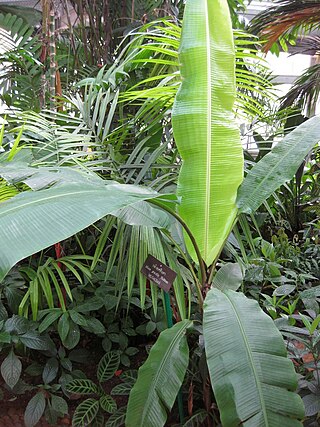
Musa is one of three genera in the family Musaceae. The genus includes 83 species of flowering plants producing edible bananas and plantains. Though they grow as high as trees, banana and plantain plants are not woody and their apparent "stem" is made up of the bases of the huge leaf stalks. Thus, they are technically gigantic herbaceous plants. Musa species are used as food plants by the larvae of some Lepidoptera species, including the giant leopard moth and other Hypercompe species, including H. albescens, H. eridanus, and H. icasia.
Musa maclayi is a species of seeded banana native to Papua New Guinea and the Solomon Islands. It is placed in section Callimusa. It is regarded as one of the progenitors of the Fe'i banana cultivars.

Musa ornata, the flowering banana, is one of more than 50 species of banana in the genus Musa of the family Musaceae. Most of these species are large tropical evergreen perennials, mainly from lowland areas with high temperature and humidity. Musa ornata originated in southeast Asia, and is cultivated for its commercial and ornamental value. The fruit is attractive but tends to be inedible.
Musa tuberculata is a tropical Asian species of plant in the banana family native to the Malesian region (Brunei). It is one of fourteen species of Musa endemic to the island of Borneo. The specific epithet "tuberculata" is from the Latin meaning "covered with minute tubercles". M. tuberculata is placed in section Callimusa, members of which have a diploid chromosome number of 2n = 20.
Musa salaccensis, commonly called Javanese wild banana, is a Malesian tropical species of plant in the banana family native to the islands of Sumatra and Java, in Indonesia. It is placed in section Callimusa, members of which have a diploid chromosome number of 2n = 20.

Fe'i bananas are cultivated plants in the genus Musa, used mainly for their fruit. Unlike most other cultivated bananas they are diploids of the AA-type. They are very distinct in appearance and origin from the majority of bananas and plantains currently grown. Found mainly in the islands of the Pacific, particularly French Polynesia, Fe'i bananas have skins which are brilliant orange to red in colour with yellow or orange flesh inside. They are usually eaten cooked and have been an important food for Pacific Islanders, moving with them as they migrated across the ocean. Most are high in beta-carotene.
Musa muluensis is a plant in the banana and plantain family. It is native to tropical Asia; found only in Sarawak in Malaysia. It is placed in section Callimusa, members of which have a diploid chromosome number of 2n = 20.

Musa coccinea, commonly known as scarlet banana or red-flowering banana, is a species of flowering plant in the banana and plantain family Musaceae, native to tropical China and Vietnam. It is a bat-pollinated evergreen perennial, placed in section Callimusa, having a diploid chromosome number of 2n = 20.

Musa beccarii is a species of wild banana, found in Malaysia, in Sabah. It is placed in section Callimusa.

Musa jackeyi is a species of wild banana in the Banana Family (Musaceae).. It is placed in section Callimusa. It has only a small native range in north-east Queensland, Australia. It is the second tallest banana species after Musa ingens, having petioles (stalks) up to 33 ft (10 m) in height, topped by laminae (blades) 14.5 ft (4.4 m) long by 2 ft (61 cm) in width, for a total height of up to 47.5 ft (14.5 m). It resembles the cultivated bananas called "fe'i" or "fehi", having an upright rather than a drooping fruit stalk, with the green terminal bud pointing upwards, and sap which is reddish in colour.
Musa barioensis is a species of wild banana, native to Sarawak, Malaysia. It is placed in section Callimusa, having a diploid chromosome number of 2n = 20.
Musa bauensis is a species of wild banana, native to Sarawak, Malaysia. It is placed in section Callimusa, having a diploid chromosome number of 2n = 20.
Musa borneensis is a species of wild banana, native to the island of Borneo, in the Malaysian states of Sabah and Sarawak. It is placed in section Callimusa, having a diploid chromosome number of 2n = 20.
Musa exotica is a species of wild banana, native to Vietnam. It is placed in section Callimusa, having a diploid chromosome number of 2n = 20. It was only described in 2004, from a collection in the Cúc Phương Forest Reservation, Ninh Bình Province, Vietnam. The clear orange bud is upright; small yellow bananas develop below the male flowers.

Musa gracilis is a species of wild banana, native to Peninsular Malaysia. It is placed in section Callimusa, having a diploid chromosome number of 2n = 20. It grows to less than 2 m (7 ft) tall. It has an upright pink-purple bud and produces narrow fruits (bananas), which have magenta and green stripes.
Musa johnsii is a species of wild banana, native to western New Guinea. It is placed in section Callimusa, having a diploid chromosome number of 2n = 20.
Musa lawitiensis is a species of wild banana, native to the island of Borneo. It is placed in section Callimusa, having a diploid chromosome number of 2n = 20.

Musa lolodensis is a species of wild banana, occurring naturally from the Moluccas through to New Guinea. It is placed in section Callimusa, having a diploid chromosome number of 2n = 20. It is one of the possible parents of the cultivated Fe'i bananas.
Musa peekelii is a species of wild banana, native to eastern New Guinea and the Bismarck Archipelago. It is placed in section Callimusa, members of which have a diploid chromosome number of 2n = 20. It is a very tall plant, reaching over 10 m (33 ft), with a narrow green drooping bud. The ripe bananas are red with bright yellow flesh. It is one of the possible parents of the cultivated Fe'i bananas.
Musa viridis is a species of wild banana, native to northern Vietnam. It is placed in section Callimusa, members of which have a diploid chromosome number of 2n = 20.







